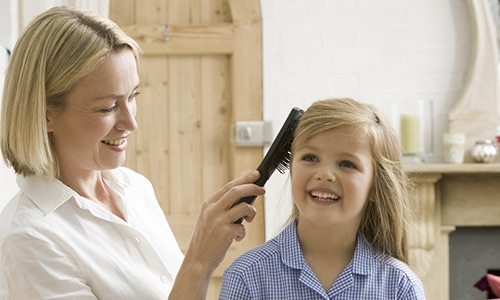We all dread that call or letter saying there has been a lice infestation at our child’s school. It is also distressing when a friend or another family member has lice. Luckily, there are precautions you can take to keep your friends and family lice-free. While these tips do not guarantee a lice-free household, they greatly reduce the chances of getting lice and are the best place to start.

- Avoid head to head contact. This is the primary method for keeping your friends and family lice-free. Lice are most often spread through direct contact since they are unable to jump or fly. They need human blood to survive, and they are attracted to the warmth of the human body, so they don’t last long removed from that comfortable environment. It is important to share this information with your children and any other friends or family members who are unaware. Children very often touch heads when playing or at sleepovers, so it is imperative to stress this tip for preventing a lice infestation in your household.
- Do not share anything that touches the head or ears. Although lice only live 48 hours or less when removed from the human head, there is still that short window of time where they can find their way back to another host. This is why learning not to share anything that touches our heads is essential. While it may be easier for adults to avoid sharing these items, it is often not so simple for children. Children love to share with their friends and siblings, and can seem strange and unfriendly not doing so. Spend time instructing your children on the importance of not sharing the following items and WHY it is important:
Items not to share: pillows, combs, brushes, hair clips or ties, headbands or other accessories, hats, helmets, scarves, coats or sweaters with hoods, towels, headphones or earbuds
- Take precaution in shared spaces. While less of a concern due to the short louse lifetime, it is good to take special precautions in shared spaces, especially for children. In places such as lockers, cubbies, coat racks, etc., there is a chance of spreading lice from one person to another. Keep items such as hats, scarves, hooded sweaters or coats away from the shared spaces or contained in a bag or backpack.
- Know what you are looking for. Spend some time learning about head lice. Read up on what they look like and the length of their life cycle. The more you know, the better you will be at recognizing a problem and taking appropriate actions to remedy it. Lice are a nuisance but do not cause a health threat, so be sure to assure your friends and family of this so they can put aside those fears.
If you or anyone in your household is found to have lice, then have no fear, Pediatric Hair Solutions is here! We have a quick and effective treatment that is safe for the entire family.

Recent Comments